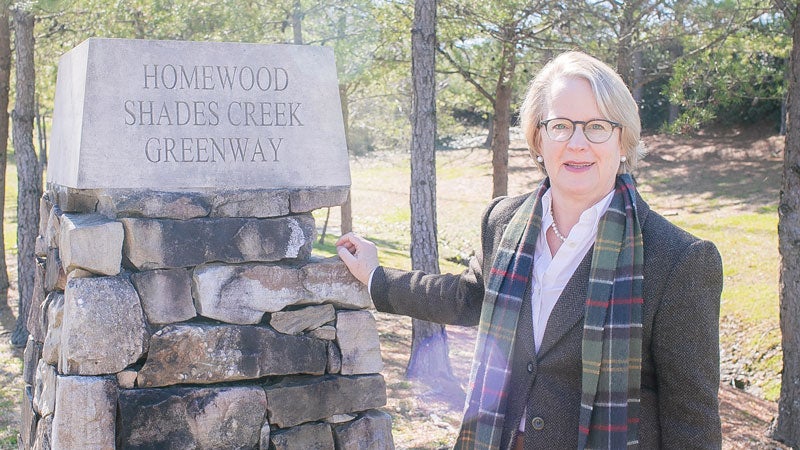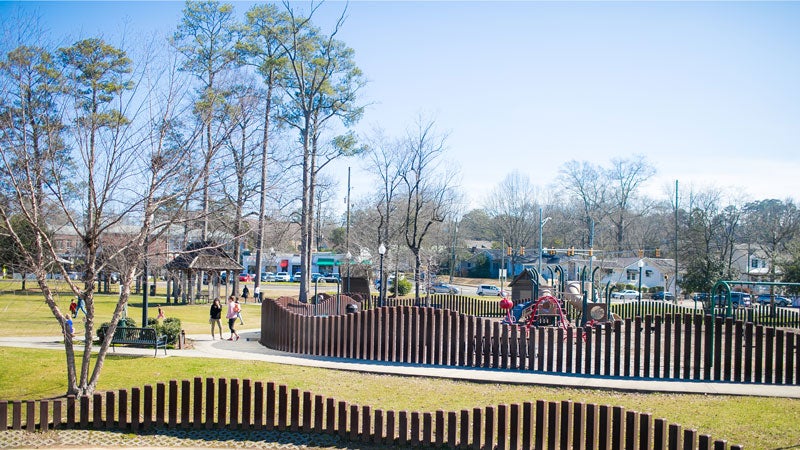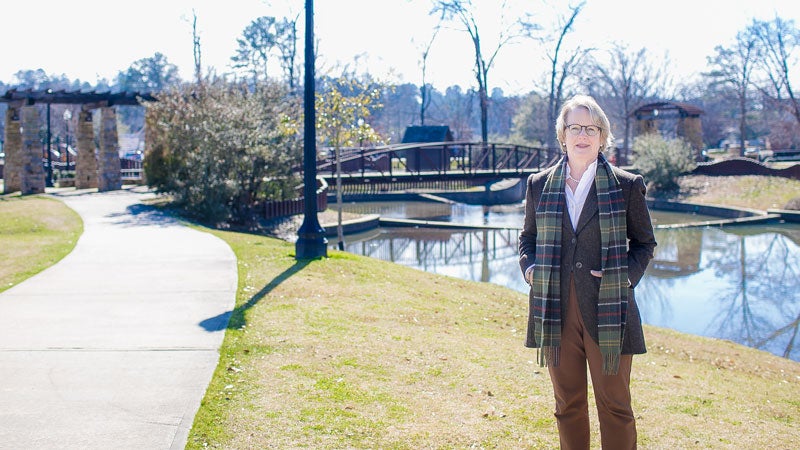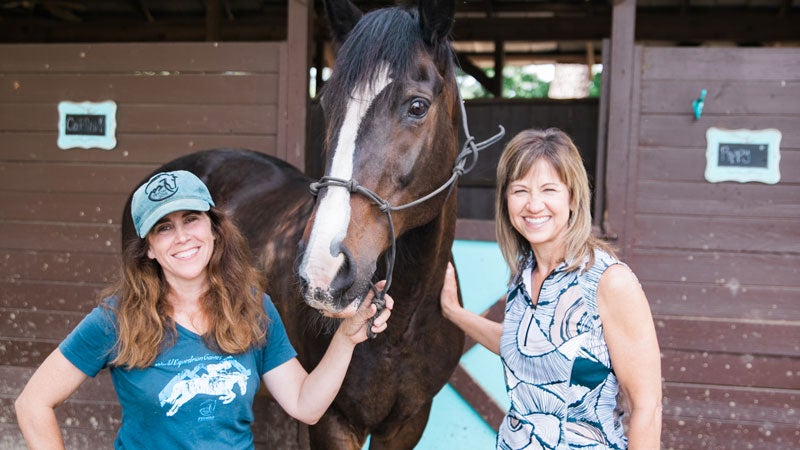Perched on a stool at the kitchen counter of her 1947 Edgewood bungalow, with a full moon casting light on the courtyard just outside, Jane Reed Ross watches her husband, Neil, cook. It’s one of her favorite things to do here at the cottage they’ve owned for nearly 30 years, where they’ve raised two sons now in their 20s. Tonight, as he shepherds andouille sausages and root vegetables in a sizzling pan along with herbs from their garden, Jane talks about dieting—but not the usual kind.
“We’re putting 18th Street on a road diet,” she says, referring to the stretch between Rosedale Drive and 28th Avenue South in downtown Homewood. “You know how wide, wide, wide the street is there. We’re going to slim it up, add trees, parking and a sidewalk. It’s going to be more intimate, a nice, safe, pedestrian-friendly feel.”
Jane is the right person for the reimagining.
As lead landscape architect of Goodwyn Mills Cawood’s Birmingham office, and as owner of her own landscape architecture firm in past years, she has designed some of the most beloved public and private outdoor spaces in Homewood and beyond. She sees past what’s worn and dysfunctional and transforms it for the greener. If you’ve ever enjoyed Homewood’s Shades Creek Greenway, Homewood Central Park, the Red Rock Trail System and the Rotary Trail, or Birmingham Children’s Zoo (just a partial list), you’ve experienced Jane’s metamorphic design vision.
 Homewood Mayor Scott McBrayer was a city council member in 2003 when the Shades Creek Greenway opened and began enchanting walkers, runners, roller bladers, bicyclists and birdwatchers alike. “Jane really educated us and did an excellent job convincing Homewood that it would be good for the city,” he says of the 3-mile paved trail that winds along Shades Creek and Lakeshore Drive between Columbiana Road and Brookwood Village. “Jane is a joy to work with and so creative,” he says, “letting you see the possibilities of a project before you get started. She can take a blank canvas, paint the whole picture, and say, ‘If we do this, this, and this, here’s what it’ll look like in the end.’”
Homewood Mayor Scott McBrayer was a city council member in 2003 when the Shades Creek Greenway opened and began enchanting walkers, runners, roller bladers, bicyclists and birdwatchers alike. “Jane really educated us and did an excellent job convincing Homewood that it would be good for the city,” he says of the 3-mile paved trail that winds along Shades Creek and Lakeshore Drive between Columbiana Road and Brookwood Village. “Jane is a joy to work with and so creative,” he says, “letting you see the possibilities of a project before you get started. She can take a blank canvas, paint the whole picture, and say, ‘If we do this, this, and this, here’s what it’ll look like in the end.’”
Jane has learned reaching that end result in the public sector calls for time and patience. “These kinds of projects take years to develop,” she says, having first started concepts and funding attempts for a Shades Creek trail in the early 1990s. “You have to gain consensus and keep pushing it along for it to weather. Things that are worthy, people will come back to them.”
There are plans to extend the trail to West Homewood Park in one direction and Mountain Brook’s Jemison Park in the other. The combined 6 miles will connect three major neighborhoods, two high schools, one university, two parks and three shopping districts, with the potential to expand even further to Red Mountain Park and beyond, as part of the Red Rock Ridge Trail System that Jane’s GMC team designed along with the Fresh Water Land Trust. “That’s what I love, connecting the dots, creating spaces where people can enjoy active lifestyles,” she says.
The Huntsville native grew up helping tend her family’s huge vegetable garden, but it was the trails and parks of Washington, D.C., that sparked her passion for connected public spaces. While pursuing her landscape architecture degree from Auburn, she spent five summers interning in D.C. “I rode my bike everywhere—taking the Rock Creek Park and George Washington Memorial Parkway from Maryland, where I lived, to Mount Vernon, George Washington’s house in Virginia. For a landscape architect to experience all those public spaces, trails and parks was great for my design vocabulary, and it was wonderful to see how they improved people’s quality of life. So to venture with the Shades Creek Greenway and create something like that here—that was big, that was fun.”
And fun seems to be the common denominator between Jane’s creative process and the experience people have in the spaces she designs. Ashley Groves, who works near the greenway, runs on it regularly. “I’m always happy there,” she says. “You feel like you’ve escaped to a secret wilderness in the city, and everybody you encounter seems so glad to be there, enjoying nature.”
 Plentiful positive feedback to the trail helped Jane land her next big Homewood transformation project. “I love it when your client demands the best and wants to do something really creative and break some eggs,” she says. “And we broke some eggs on Homewood Central Park.” A straight-line channeled creek with concrete block walls and chain link fence divided the park into two awkward pieces, and during peak storms, the rushing water caused flooding issues. “People with houses that backed up to the creek downstream used to have to sandbag their homes,” says Jane. “We dechannelized and undulated it through the park, allowing it to flood the banks in storms and become slow-moving water, an environmentally sustainable thing to do.” That in turn opened a huge new lawn space, perfect for festivals and movie nights.
Plentiful positive feedback to the trail helped Jane land her next big Homewood transformation project. “I love it when your client demands the best and wants to do something really creative and break some eggs,” she says. “And we broke some eggs on Homewood Central Park.” A straight-line channeled creek with concrete block walls and chain link fence divided the park into two awkward pieces, and during peak storms, the rushing water caused flooding issues. “People with houses that backed up to the creek downstream used to have to sandbag their homes,” says Jane. “We dechannelized and undulated it through the park, allowing it to flood the banks in storms and become slow-moving water, an environmentally sustainable thing to do.” That in turn opened a huge new lawn space, perfect for festivals and movie nights.
Melissa Mohon Francis grew up playing in the park in its “before” days. Twelve years ago, she and her husband moved from Chicago to a house a block from the space, after its transformation. “The park was one of the big reasons we bought the house. My children play there all the time,” she says, “and now we’re renovating for more room, because I can’t leave. The park is a part of my life,” says Francis, who walks her dog and roller skates with a friend there a few days a week. “After the improvements, you felt like you were going somewhere instead of just playing in the dirt pile. That creek used to be kind of gross, but when they put the bridge over it, it felt like the waterway was a beautiful flowing thing. It changed Homewood.”
When it comes to the most dramatic change of a public landscape, Jane says Birmingham’s Rotary Trail, completed in 2016, wins in her book. “It was such a blighted area. And dangerous. The concrete was falling in,” she says of the former abandoned railroad bed that’s now a four-block linear park, dappled with river birches and ornamental grasses, benches and smartphone charging stations.
“There are people who think Birmingham is just evolving right now, but this renaissance that we’re experiencing didn’t happen overnight. It’s been a lot of people working hard for over 30 years,” says Jane, who is serving as state president of the American Society of Landscape Architects for the second time, her first 20 years ago. “I took the leadership on again because I believe it’s an important time in promoting public green space and sustainability. It’s key to our quality of life to reduce temperatures with green space and proper storm water management. The flooding in Houston is a perfect example of what happens with too much paving.”
Jane is also a firm believer in uplifting and energizing people through greater connection to the natural world. “The Japanese do what’s called ‘forest bathing,’ absorbing oxygen from the trees,” she says. “And that improves well-being.” She gets particular energy from the tulip poplar. An avid landscape watercolor painter, she’s been painting tulip poplars all her life. “I really do think we absorb energy from plants. That’s why walking in nature is so important. Being able to create spaces where people can enjoy the outdoors is enriching beyond words. It’s a fun ride.”
 Jane’s Landscaping 411
Jane’s Landscaping 411
The Secret to Having a Green Thumb: Manure. I grew up gardening with my dad, who grew up gardening on the farm, and he taught me early that manure is key to organic components in the soil. The best fertilizer you can get.
Favorite Ground Cover: Asiatic jasmine. It grows in sun or shade, so when you have a yard with both conditions, you can do a continuous swath for a big green carpet statement. You need to edge it; it will grow into the street.
Biggest Mistake Home Gardeners Make: Placing a plant in the wrong spot, such as a tall tree under a power line or a large shrub in front of a window, which will require constant pruning.
Top Low-Maintenance Plant: Oak leaf hydrangea is one of my favorites, a gorgeous plant that’s native to our area. Good in shade and part sun.
Advice for Starting a Landscape Renovation: Look at how you live and what’s important to you. Usually when I work on a residence, I try to provide a flow of indoor/outdoor spaces. Our den and kitchen open onto our patio and courtyard, so we have good flow. I wouldn’t want to live anywhere without that.
An Outdoor ‘Room’ is Incomplete Without: Comfortable seating. A place for everyone to gather around a table. The sound of trickling water in a fountain. And either a view from beyond or a natural buffer creating your view in the foreground. That might be the fountain and a multi-trunk serviceberry, or a lawn, or a bed of ferns under a holly tree.
Favorite Shade Tree: An overcup oak grows fast for a hardwood, maintains a great shape, and best of all, is native to our area. It’s important to our landscape to use native trees for a healthy canopy. Homewood Environmental Commission has been partnered with the Birmingham Botanical Gardens in a tree planting program started by Henry Hughes, also from Homewood, called Green Skies. For four years, we’ve planted 300 seedlings started from local trees each fall.
Great Border: Korean boxwood, but it’s high maintenance. I prefer a low maintenance landscape with a natural look where you don’t have a border, such as undulating massing of oakleaf hydrangea, shield fern, beautyberry, pink muhly grass and black-eyed Susan.
Best Natural Privacy Wall: I like an informal, undulating evergreen buffer using different types of hollies and magnolias.











